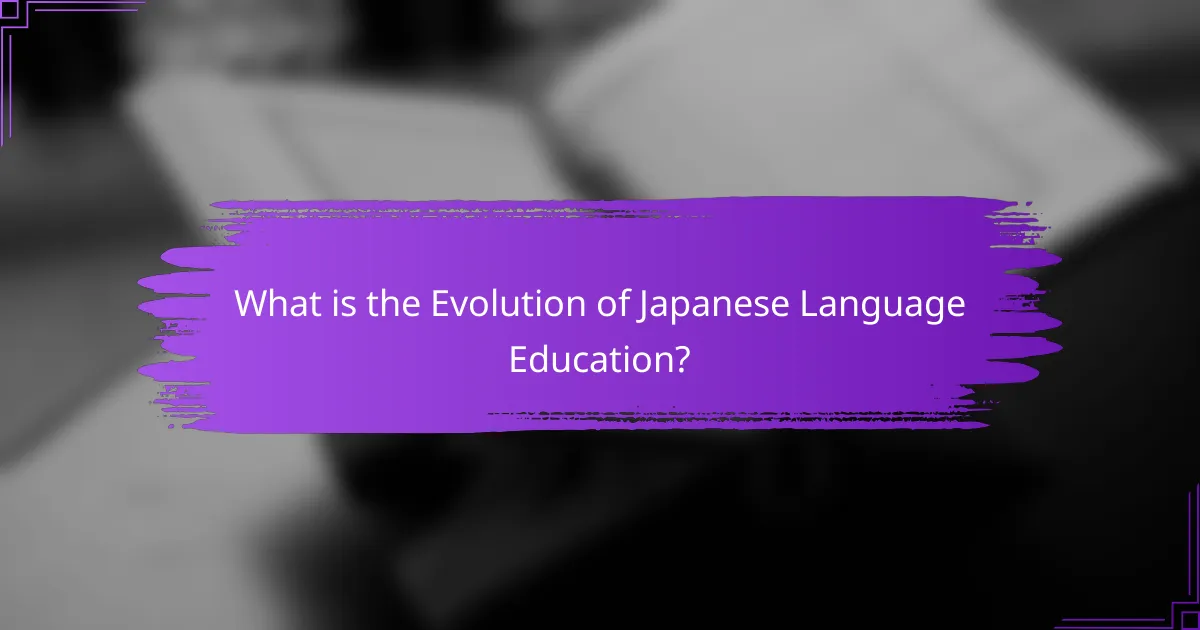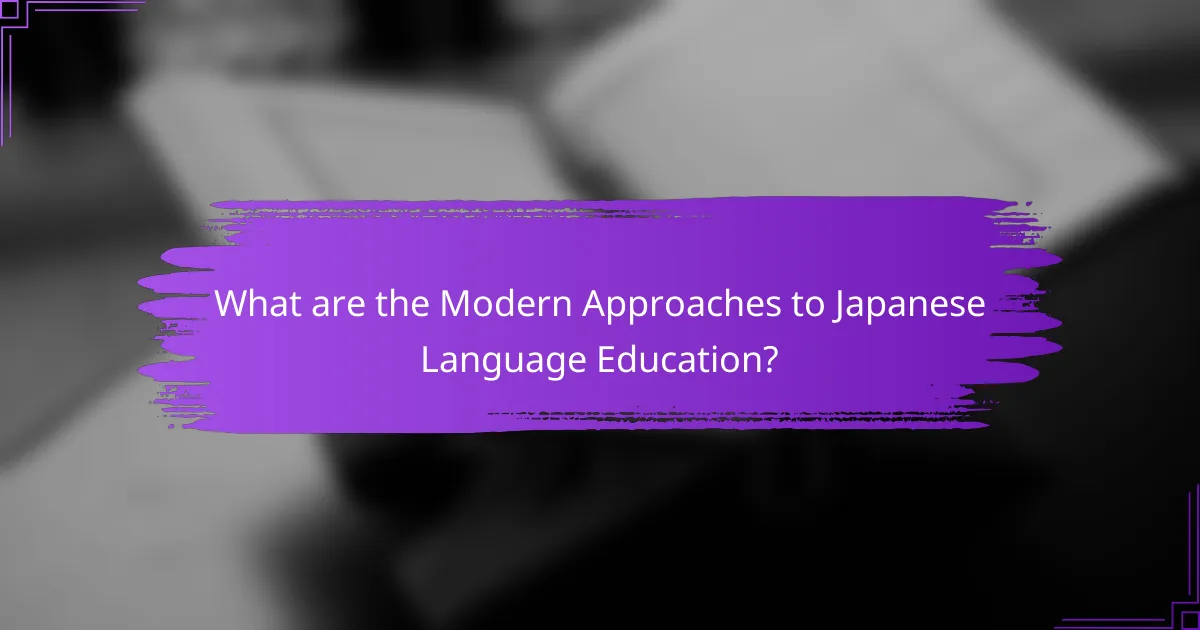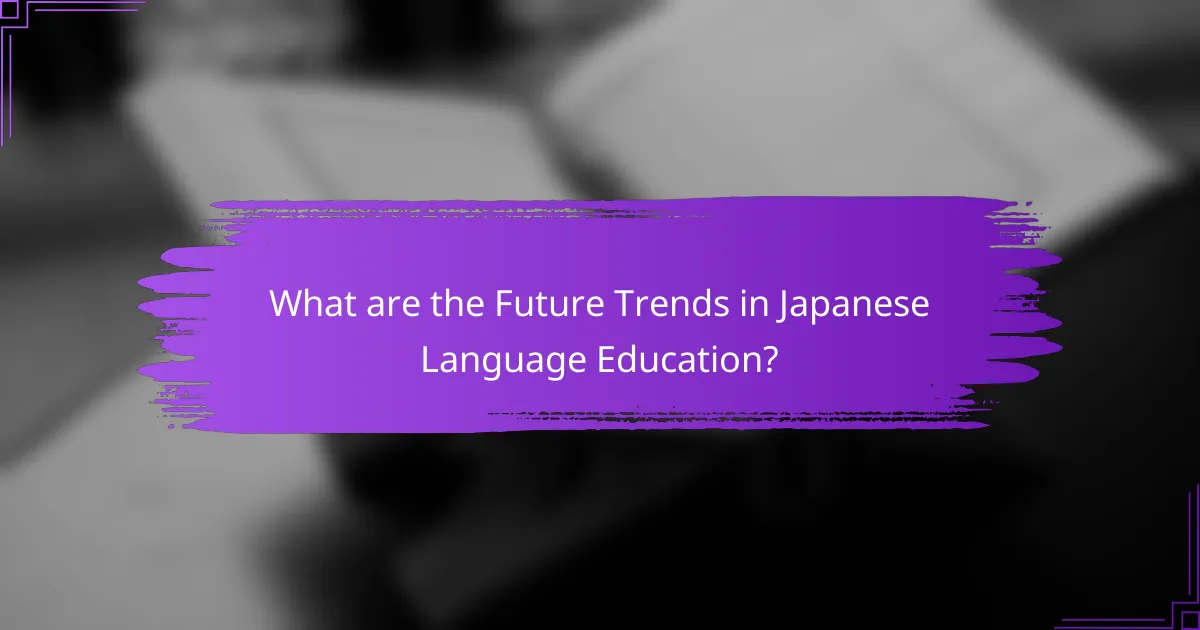
What is the Evolution of Japanese Language Education?
The evolution of Japanese language education has progressed through several distinct phases. Initially, in the early 20th century, Japanese language instruction focused on reading and writing classical texts. This was primarily aimed at students in Japan and abroad seeking to understand Japanese literature and culture.
Post-World War II, the emphasis shifted towards communicative competence. The introduction of modern teaching methods aimed to enhance speaking and listening skills. This period saw the development of textbooks and resources tailored for foreign learners.
In the 1980s, the Japanese government began promoting the study of the language globally. Initiatives included the establishment of language institutes and scholarships for international students. These efforts increased the number of learners worldwide.
Today, Japanese language education incorporates technology and multimedia resources. Online courses and language exchange platforms have become popular. These modern approaches cater to diverse learning preferences and enhance accessibility.
Overall, the evolution reflects a transition from classical education to a more communicative and technology-driven approach. This shift has made Japanese language education more effective and widespread.
How has Japanese language education changed over time?
Japanese language education has evolved significantly over time. Initially, it focused on classical texts and rote memorization. In the Meiji period, Western influences introduced new teaching methods. The post-World War II era emphasized communicative competence and practical usage. Recent trends incorporate technology and interactive learning tools. Additionally, immersion programs have gained popularity. These changes reflect broader educational reforms and globalization. Today, Japanese language education aims to balance linguistic skills with cultural understanding.
What historical milestones have influenced Japanese language education?
The historical milestones that have influenced Japanese language education include the Meiji Restoration, which began in 1868. This period marked a significant shift towards modern education and the adoption of Western teaching methods. The introduction of compulsory education in 1872 further standardized Japanese language instruction across the nation.
In 1947, the post-war education reforms established a new curriculum emphasizing Japanese language proficiency. The implementation of the Course of Study by the Ministry of Education in 1989 set national guidelines for language education. The rise of globalization in the 21st century has also led to increased interest in Japanese language learning worldwide.
These milestones reflect the evolution of language education practices in Japan and their adaptation to social and political changes.
How have societal changes impacted the evolution of Japanese language education?
Societal changes have significantly influenced the evolution of Japanese language education. The post-World War II era saw a shift in educational policies. This period emphasized democratization and increased access to education. As a result, Japanese language education became more structured and standardized. The rise of globalization has further impacted language education. Increased international interactions necessitated a focus on Japanese as a foreign language. Technological advancements also transformed teaching methods. Online resources and digital platforms have made learning more accessible. Furthermore, societal attitudes towards bilingualism have evolved. There is now greater acceptance and encouragement of learning multiple languages. These changes collectively reflect the dynamic nature of Japanese language education.
What role does historical context play in Japanese language education?
Historical context significantly influences Japanese language education. It shapes curriculum design, teaching methods, and learner motivations. For instance, the Meiji Restoration in the 19th century prompted modernization in education, emphasizing the need for Japanese language proficiency. This period introduced Western educational practices and materials. Additionally, post-World War II reforms focused on democratizing education, leading to increased accessibility. Historical events, such as Japan’s globalization efforts, have also impacted language teaching approaches. These changes reflect shifting societal needs and values over time.
How did the Meiji Restoration affect language education in Japan?
The Meiji Restoration significantly transformed language education in Japan. It marked a shift from classical Chinese to a focus on the Japanese language. The government implemented reforms to modernize education and promote a national identity. These reforms included the establishment of a public education system. The new curriculum emphasized Japanese language and literature. Textbooks were created to standardize language instruction. The introduction of Western languages also began during this period. This change aimed to facilitate international communication and modernization. Overall, the Meiji Restoration laid the foundation for contemporary language education in Japan.
What were the influences of World War II on Japanese language education?
World War II significantly influenced Japanese language education. The war led to a shift in educational policies in Japan. After the war, the Allied Occupation implemented reforms that emphasized democratic values. These reforms included changes in language education to promote English and other foreign languages. The focus on English was aimed at fostering international communication. Japanese language education also underwent changes to remove militaristic and nationalistic content. This transformation aligned with the broader goal of promoting peace and cooperation. The introduction of new teaching methodologies reflected these educational reforms. Overall, the war catalyzed a re-evaluation of language education in Japan.

What are the Modern Approaches to Japanese Language Education?
Modern approaches to Japanese language education include communicative language teaching, task-based learning, and technology integration. Communicative language teaching focuses on interaction as the primary means of language learning. This method encourages students to engage in real-life communication scenarios. Task-based learning emphasizes the completion of meaningful tasks to enhance language acquisition. It promotes practical usage of the language in context. Technology integration involves using digital tools and resources to facilitate learning. This can include language learning apps, online courses, and interactive platforms. Research shows that these modern approaches increase student engagement and improve language proficiency. For instance, a study by the Japan Association for Language Education and Technology highlights the effectiveness of technology in enhancing language skills.
How do contemporary teaching methods differ from traditional ones?
Contemporary teaching methods prioritize student-centered learning, while traditional methods focus on teacher-led instruction. In contemporary settings, collaboration and critical thinking are emphasized. Students engage in group work and discussions, fostering a deeper understanding of the material. Traditional methods often rely on rote memorization and lectures. Assessment in contemporary education includes formative feedback, encouraging ongoing improvement. Traditional assessments typically focus on final exams and standardized tests. Technology integration is common in contemporary classrooms, enhancing learning experiences. Traditional classrooms often lack technological resources, limiting engagement. Research indicates that active learning strategies improve retention and comprehension, supporting the effectiveness of contemporary methods.
What innovative techniques are being used in Japanese language classrooms today?
Innovative techniques in Japanese language classrooms today include the use of technology, immersive learning, and collaborative projects. Technology enhances learning through apps and online resources. Immersive learning involves real-life simulations and cultural experiences. Collaborative projects encourage teamwork and communication among students. These methods have been shown to improve language retention and engagement. Research indicates that technology integration can boost student motivation and learning outcomes.
How does technology enhance modern Japanese language education?
Technology enhances modern Japanese language education by providing interactive and immersive learning experiences. Digital tools like language learning apps facilitate vocabulary acquisition through gamification. Online platforms enable real-time communication with native speakers, fostering practical language use. Multimedia resources, such as videos and podcasts, improve listening comprehension and cultural understanding. Virtual classrooms allow flexible learning schedules, accommodating diverse student needs. Research indicates that technology integration leads to higher engagement and retention rates in language learning. For instance, a study published in the Journal of Language Teaching and Research found that students using technology showed a 30% improvement in language proficiency over traditional methods.
What are the challenges faced in modern Japanese language education?
Modern Japanese language education faces several challenges. One significant challenge is the lack of qualified teachers. Many educators may not have sufficient training in teaching Japanese as a second language. Additionally, there is often a shortage of resources and materials tailored for diverse learning needs. This limits effective teaching strategies and student engagement.
Another challenge is the varying levels of student motivation and interest. Some learners may struggle with the complexity of the language, particularly kanji. This can lead to frustration and decreased retention of knowledge. Furthermore, the integration of technology in language education can be inconsistent. While some institutions embrace digital tools, others lag behind, affecting the learning experience.
Cultural differences also pose challenges. Students may find it difficult to understand cultural nuances embedded in the language. This can hinder effective communication and comprehension. Overall, these challenges impact the effectiveness and accessibility of modern Japanese language education.
How do cultural attitudes influence language learning in Japan?
Cultural attitudes significantly influence language learning in Japan. The Japanese culture emphasizes respect, hierarchy, and group harmony. These values impact the language learning process, as students often prioritize formal and polite language forms. Additionally, there is a strong societal expectation for proficiency in English, driven by globalization and economic factors. This creates a pressure to succeed in language acquisition. Research shows that students’ motivation is closely tied to their cultural identity and the perceived importance of language skills for future opportunities. Furthermore, traditional teaching methods, rooted in rote memorization, reflect cultural attitudes towards discipline and diligence in education.
What barriers exist for non-native speakers learning Japanese today?
Non-native speakers face several barriers when learning Japanese today. The complexity of the writing system is a significant challenge. Japanese uses three scripts: Hiragana, Katakana, and Kanji. Kanji alone has thousands of characters, making literacy difficult for learners. Additionally, the grammar structure differs greatly from many other languages. This can lead to confusion in sentence construction and verb conjugation.
Cultural nuances also pose a barrier. Understanding context and politeness levels is essential in Japanese communication. Many learners struggle with these subtleties, which can affect their fluency. Furthermore, limited access to immersive environments can hinder practice. Non-native speakers often lack opportunities to engage with native speakers.
Lastly, resources for learning can be inconsistent. While there are many textbooks and online courses, the quality varies. This inconsistency can lead to ineffective learning experiences. These barriers collectively make Japanese a challenging language for non-native speakers.

What are the Future Trends in Japanese Language Education?
Future trends in Japanese language education include increased integration of technology and personalized learning. Online platforms and mobile applications are becoming essential tools for language acquisition. Virtual reality and augmented reality are being explored to create immersive learning experiences. Additionally, artificial intelligence is being utilized to provide tailored feedback to learners. Collaborative learning environments are gaining popularity, fostering peer interaction and cultural exchange. Furthermore, there is a growing emphasis on communicative competence over rote memorization. This shift aligns with global educational trends that prioritize practical language use. Research indicates that these methods enhance engagement and retention among students.
How is globalization impacting Japanese language education?
Globalization is significantly impacting Japanese language education by increasing demand for Japanese language skills worldwide. The rise of Japanese pop culture, including anime and manga, has spurred interest in learning the language. Additionally, international business relations with Japan have led to more educational programs focused on Japanese. According to a 2021 report by the Japan Foundation, the number of learners outside Japan grew by over 30% in the past decade. This trend has prompted educational institutions to adapt curricula to incorporate global perspectives. Online learning platforms have also emerged, making Japanese language education more accessible. Furthermore, cultural exchange programs are facilitating immersive learning experiences. Overall, globalization is reshaping how Japanese is taught and learned across the globe.
What role do online platforms play in the future of language learning?
Online platforms play a crucial role in the future of language learning. They provide accessible resources for learners worldwide. These platforms offer interactive tools that enhance engagement. Many utilize gamification to make learning enjoyable. Online platforms also facilitate real-time communication with native speakers. This interaction boosts conversational skills significantly. Furthermore, they allow personalized learning experiences tailored to individual needs. Research indicates that online learning can improve language retention rates by up to 25%.
What best practices can enhance Japanese language education?
Utilizing immersive language experiences enhances Japanese language education. Immersion allows learners to practice Japanese in real-life contexts. Research shows that immersion leads to better language retention and fluency. Incorporating technology, such as language apps, also supports learning. These tools provide interactive exercises and instant feedback. Collaborative learning through group activities fosters communication skills. Studies indicate that peer interaction boosts language acquisition. Regular assessments help track progress and identify areas for improvement. Overall, these practices create a comprehensive learning environment.
How can educators effectively engage students in learning Japanese?
Educators can effectively engage students in learning Japanese through interactive methods. These methods include using multimedia resources, such as videos and games. Incorporating cultural elements enhances motivation and interest. Group activities promote collaboration and communication among students. Regular assessments help track progress and identify areas for improvement. Real-life language practice boosts confidence and fluency. Research shows that active participation increases retention and understanding. Engaging teaching strategies lead to better learning outcomes in language education.
What resources are available for learners of the Japanese language?
Resources available for learners of the Japanese language include textbooks, online courses, language apps, and tutoring services. Textbooks such as “Genki” and “Minna no Nihongo” provide structured learning. Online platforms like Duolingo and Rosetta Stone offer interactive lessons. Language apps such as Anki assist with vocabulary retention through flashcards. Tutoring services, both in-person and online, connect learners with native speakers for practice. Additionally, language exchange programs allow learners to converse with Japanese speakers. These resources collectively enhance the learning experience and cater to various learning styles.
The main entity of the article is Japanese language education, which has evolved through various historical phases and modern approaches. Initially focused on classical texts, the education system shifted post-World War II towards communicative competence and practical usage. Key historical milestones, such as the Meiji Restoration and globalization, have significantly impacted teaching methodologies and learner motivations. Current trends emphasize technology integration and immersive learning experiences, addressing challenges faced by both native and non-native speakers. The article outlines best practices and resources available to enhance the effectiveness of Japanese language education today.